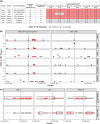The ZFHX3 GGC Repeat Expansion Underlying Spinocerebellar Ataxia Type 4 has a Common Ancestral Founder
- PMID: 39635987
- PMCID: PMC11832790
- DOI: 10.1002/mds.30077
The ZFHX3 GGC Repeat Expansion Underlying Spinocerebellar Ataxia Type 4 has a Common Ancestral Founder
Abstract
Background: The identification of a heterozygous exonic GGC repeat expansion in ZFHX3 underlying spinocerebellar ataxia type 4 (SCA4) has solved a 25-year diagnostic conundrum. We used adaptive long-read sequencing to decipher the pathogenic expansion in the index Utah family and an unrelated family from Iowa of Swedish ancestry. Contemporaneous to our discovery, other groups identified the same repeat expansion in affected individuals from Utah, Sweden, and Germany, highlighting the current pivotal time for detection of novel repeat expansion disorders.
Methods: Given that the pathogenic repeat expansion is rare on a population level, we proposed a common ancestor across all families. Here, we employed targeted long-read sequencing through adaptive sampling, enriching for the chr16q22 region of interest.
Results: Using phased sequencing results from individuals from Utah, Iowa, and Southern Sweden, we confirmed a common ~2000-year-old ancestral haplotype harbouring the repeat expansion.
Conclusion: This study provides further insight into the genetic architecture of SCA4. © 2024 The Author(s). Movement Disorders published by Wiley Periodicals LLC on behalf of International Parkinson and Movement Disorder Society.
Keywords: ataxia; haplotype; long‐read sequencing; repeat expansion disorder; spinocerebellar ataxia type 4.
© 2024 The Author(s). Movement Disorders published by Wiley Periodicals LLC on behalf of International Parkinson and Movement Disorder Society.
Figures

References
-
- Chen Z, Gustavsson EK, Macpherson H, Anderson C, Clarkson C, Rocca C, et al. Adaptive long‐read sequencing reveals GGC repeat expansion in ZFHX3 associated with spinocerebellar ataxia type 4. Mov Disord 2024;39(3):486–497. - PubMed
-
- Paucar M, Nilsson D, Engvall M, Laffita‐Mesa J, Söderhäll C, Skorpil M, et al. Spinocerebellar ataxia type 4 is caused by a GGC expansion in the ZFHX3 gene and is associated with prominent dysautonomia and motor neuron signs. J Intern Med 2024;296(3):234–248. - PubMed
-
- Figueroa KP, Gross C, Buena‐Atienza E, Paul S, Gandelman M, Kakar N, et al. A GGC‐repeat expansion in ZFHX3 encoding polyglycine causes spinocerebellar ataxia type 4 and impairs autophagy. Nat Genet 2024;56(6):1080–1089. - PubMed

